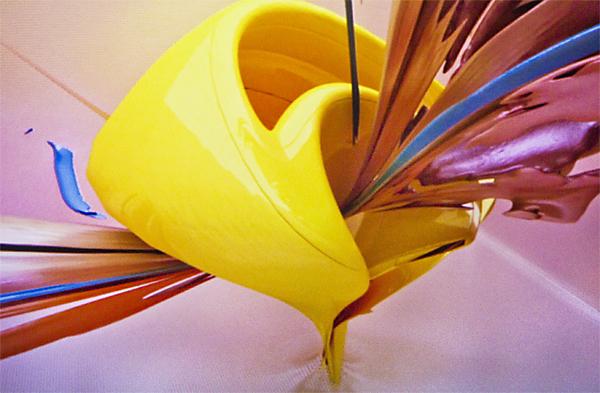Exhibit showcases 3-D advancement

Real-Fake piece by Zeitguised:Zeitguised?s award-winning piece titled ?Peripetics or The Installation of an Irreversible Axis on a Dynamic Timeline? was installed in the Library Gallery. :Ashley Neal – State Hornet
April 6, 2011
A new exhibition opened to the public on Friday displaying the works of 20 artists who used technology that was once relegated to the construction industry, video games and movies.
The exhibition, titled “The Real Fake,” will be on display until May 28 in the first floor gallery of the Library. Each art piece utilizes the virtual “XYZ” space to give each non-referenced object, a figure without substance in the 1-D and 2-D plane, depth and texture.
One of the unique pieces in the exhibition titled “The Seasons” has a plaster sculpture of a woman sitting in a chair while the virtual camera moves the figure in 3-D space in a circle. All the while flowers are growing from the body and then disappearing as the figure seems to be breathing slightly and melting away.
The artist is Claudia Hart; she is also co-curator of the exhibition. Hart is alsoan assistant professor in the department of film, video, new media and animation at the School of the Art Institute of Chicago.
She said industries using 3-D programming, such as construction firms, video game and movie studios, only ask for their designers to concentrate in specific areas within the given industry. Hart said when teaching her students to use the programming, she encourages them to explore the boundaries of the programming to create their art.
“Previously, 3-D was only taught in an industrial environment, teaching students to be cogs in a production pipeline. That means that you were educated right from the start to be a specialist and have expertise in one tiny area of the medium,” Hart said. “This is counter to the way design and art is taught in all other medium, from painting, to photography, architecture, graphic design and web design. I’ve made an effort to define 3-D as an art, a design medium like any other, and I have it taught the way other art and design media are taught.”
Hart said conventional art does not have to worry about its place in popular culture.
“Some mediums seem to be more relevant at different historical junctures, but I think traditional medium such as painting, continue to be relevant and always will be. They are historic forms and allow a viewer to see continuity between the past and the future,” Hart said. “Nevertheless, 3-D computer graphics will become more and more broadly used. They are just at the beginning of being adopted by contemporary artists.”
Library Gallery director Philip Hitchcock, alumnus of the School of the Art Institute of Chicago, was among the first to explore this medium.
“Thirty years ago I was an instructor at the institute and we called this art form genitive systems. We started out using Xerox machines and analog computers, we started some of the very first computer graphics,” Hitchcock said.
Since the inception of genitive systems 30 years ago, the art in the Library gallery can clearly be seen with the use of video projectors, LCD monitors and Apple computers.
He said if the medium can get a person to think outside the box, then it has done its job.
“I think I really enjoy people who use pencils, if, they really use them magically,” Hitchcock said. “And if they use computers magically to change my intellectual vision, like a pencil, then I am very excited.”
Hitchcock said the goal of gallery is to have community infer the true meaning of a work of art based on their senses and experiences.
“The media is not the message. The message is gained from what one sees and how a person’s horizons have been opened by it,” Hitchcock said. “It is like interpreting a pizza. A pizza is not always the same to the next person.”
Sac State assistant professor and co-curator Rachel Clarke said she was enticed by the medium for its unique characteristics.
“I was really interested in the properties of the medium because the artist can literally generate complete environments from scratch,” Clarke said. “It is entirely up to the imagination of the artist as to what they create. You are not restricted by anything that exists in the real world. Everyone should know what game designers and the film industry does with 3-D, we want the public to know as well. The idea of artists working with this technology and using their imagination in this medium is very new and young.”
Hart anticipates favorable reactions from the public as the exhibit presents a new opportunity for the public to experience something new.
“I hope they are engaged and challenged and also delighted. I think the magic-realism quality of this type of work is very seductive and draws people into it, and I hope all of the work in the show does that,” Hart said.
Matt Harrington can be reached at [email protected]




























































































































